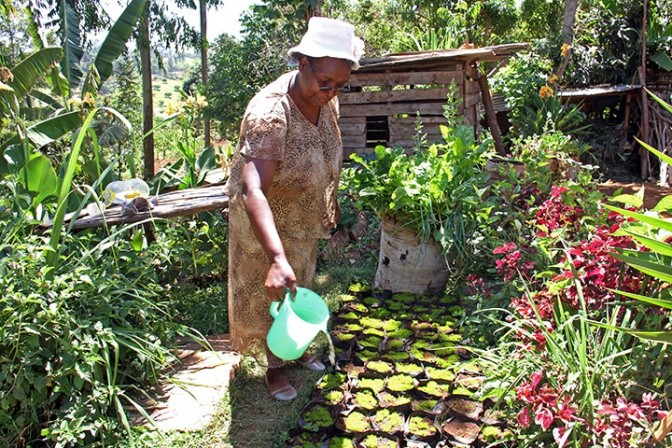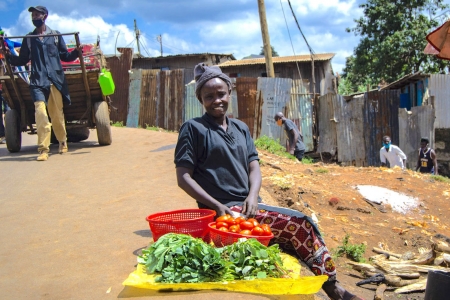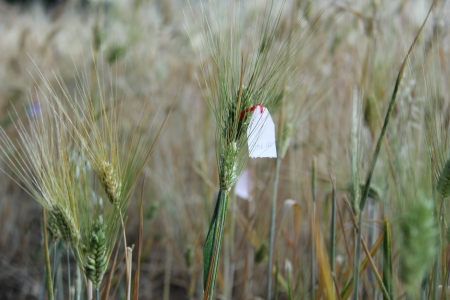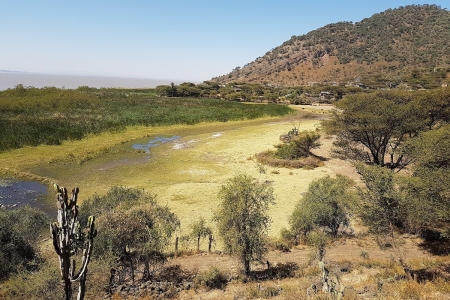Tackling rising threats to food security, water and energy supplies
Every rainy season Jane Kabugi’s home comes under attack. The torrential rain so desperately needed downstream to fuel Kenya’s rising electricity demands - and Nairobi’s water requirements - has literally been tearing her home and farm apart.
 “Our soil is very soft. So when it rains, the rain tends to take the soil away," says Jane Kabugi on her farm. Photo: Stephanie Malyon
“Our soil is very soft. So when it rains, the rain tends to take the soil away," says Jane Kabugi on her farm. Photo: Stephanie Malyon“There was a time when this house of mine was almost gone; it was starting to crack. An engineer came and said ‘if you want to save your house you need to make a strong hold so that the soil can be held’,” she said.
Like 90 per cent of the one million farmers in Kenya’s Tana region, northwest of Nairobi, Jane’s land sits on a steep hillside with a 75 percent incline. She explains: “Our soil is very soft. So when it rains, the rain tends to take the soil away. If I put manure it takes it, if I put fertiliser it takes it."
Far from just affecting farmer homes and livelihoods in one of Kenya’s most agriculturally productive areas, the knock-on effect downstream is threatening water and energy supplies. As torrents carry precious top soil away from farms into the watershed, the Tana River, which drives half of Kenya’s hydropower-generated electricity and provides 95 per cent of Nairobi’s water, becomes choked with sediment.
Today (20 March 2015), in a first for Africa, The Nature Conservancy (TNC) and partners* including the International Center for Tropical Agriculture (CIAT), launched a landmark initiative aimed at supporting farmers and upstream users, like Jane, to curb the soil erosion that leads to reduced water and heavy cleaning costs.
The Tana-Nairobi Water Fund is a public-private scheme uniting big business, utilities, conservation groups, government, researchers and farmers. It aims to increase farm productivity upstream, while improving water supply and cutting costs of hydropower and clean water for users downstream, and is designed to generate US$21.5 million in long-term benefits to Kenyan citizens, including farmers and businesses.
The Tana-Nairobi Water Fund is a public-private scheme uniting big business, utilities, conservation groups, government, researchers and farmers.
If successful, it could pave the way for ‘payment for ecosystems services’ projects across the continent. Downstream users, such as Coca-Cola, East African Breweries, and utility companies, will pay upstream “guardians” to implement strategic measures to protect the upper watershed.
These include tree planting along river banks, terracing on very steep slopes, soil conservation schemes and drip irrigation within the catchment areas expected to significantly curb soil erosion and cut soil sediment concentrations in half, depending on the location in the catchment and time of year.
The Fund models other, already successful Funds implemented by TNC in other regions, which provide secure water supplies for nearly 50 million people.
Backed by research
Research has played a major role in the development of the Tana-Nairobi Water Fund and will be vital in making sure the Fund delivers the benefits it promises.
As a research partner supported by funding from the CGIAR Research Program on Water, Land and Ecosystems (WLE), CIAT’s expertise in land-use mapping and land-use change detection is helping drive essential evidence-based and targeted investments to prevent major ecosystem damage in the most cost-effective way.
Crop suitability modelling conducted by CIAT, examines how changes in temperature and rainfall can drive land-use change. By projecting scenarios in land-use changes, partners working on the ground can advise farmers on smart cropping interventions and possible alternatives for diversification.
For example, if rangelands - which currently cover 25 percent of the Tana River’s priority watersheds - become more suitable for agriculture, then it will be crucial to advise farmers about suitable management practices, to avoid soil run-off and increased sedimentation.
While the Tana-Nairobi Water Fund currently targets farmers, research also shows that interventions will also need target other contributors to sedimentation, such as quarries and unpaved roads. Hydrological modelling shows that quarries have a major impact on soil erosion and water quality. In one of the Tana watersheds, quarries account for one quarter of all sedimentation.
“Detecting and predicting the causes of sedimentation is only part of the work”, said Fred Kizito, CIAT soil scientist. “We can only know if the Water Fund is delivering on the promises laid out in the business case, also launched by TNC today, by monitoring the impact of interventions targeted for different areas within the watershed”
Working in partnership with Kenya’s Water and Resource Management Authority, CIAT will measure real-time water quality at specific points along the watershed. CIAT will also guide land management options by measuring the effectiveness of different interventions - such as terracing and grass strips - so they can be tailored to specific areas of the watershed.
The Water Fund in action
Intervention measures are already helping Jane protect her home and her livelihood. In January 2014, she met the Sustainable Agriculture Community Development Programme (SACDEP), a Water Fund partner.
As part of a pilot scheme enabling 5,000 farmers in the upper catchment to adopt conservation measures, SACDEP trained Jane how to protect her soil by digging trenches, and planting trees, bamboo and Napier grass.
“Every trench I make at least four feet deep. But you see this one is less than six inches. It’s been covered by water and soil from the top of my farm. If the trenches were not there - my soil would have washed down and spoilt the water in the river, taking all the fertilizer and all the manure I’ve struggled to put down,” Jane explained.
With the launch of the fund, partners will now target thousands of farmers across the watershed to provide them with training and support to implement soil-saving techniques.
Jane, a retired employee of the Ministry of Agriculture, is now an upstream ‘guardian’. She shares what she has learnt with other farmers in her area, so they can protect their farms and prevent soil, manure and fertiliser from being washed away, polluting the river for downstream users. With the launch of the fund, partners will now target thousands of farmers across the watershed to provide them with training and support to implement soil-saving techniques.
Soil – a resource in trouble
The United Nations has declared 2015 the International Year of Soils, creating an opportunity to renew global awareness of the vital link between healthy, fertile soils and prosperous societies. Investing and raising awareness about what is happening to our soil – and what can be done to protect it – is now more important than ever. Find out how CIATs global soils research team of soil scientists, ecologists and anthropologists are working to protect and restore this vital resource.
Tana-Nairobi Water Fund partners: Nairobi City Water and Sewerage Company (NWC), Kenya Electricity Generating Company (KenGen), Tana and Athi Rivers Development Authority (TARDA), Water Resources Management Agency (WRMA), Pentair, East Africa Breweries, Coca-Cola, Frigoken Horticulture, the Greenbelt Movement and Sustainable Agriculture Community Development Programme (SACDEP).Media: Joint TNC-CIAT Press Release
TNC Tana-Nairobi Water Fund: Business Case
Research: WLE Tana research report
Video: The ground beneath your feet
Photos: Kenya’s Tana River watershed
Stories: Costing the earth: who’s responsible? & Could climate change spell trouble for Kenya’s largest river












Comments
Thanks for the information.